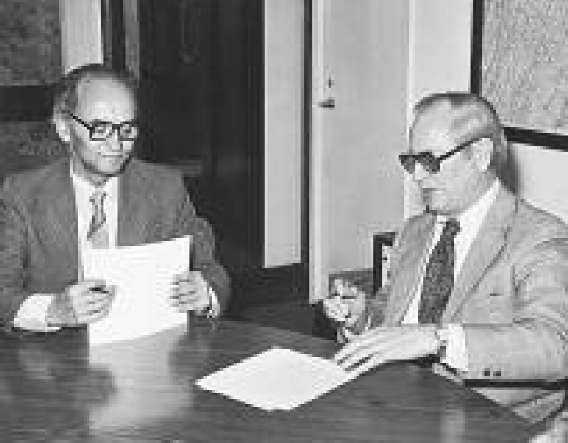(1920-1986) American Oceanographer, Plate Tectonics
William Menard is one of the pioneers of the plate tectonic revolution. He and a small group of revolutionaries from England and the United States finally put the smoking-gun evidence to Alfred Wegener’s hypothesis of moving continents. Through a series of research cruises, this group proved seafloor spreading. They looked at the bathymetry of mid-ocean ridges as well as the mirroring of magnetic stripes on the ocean floor on either side of them. These data were assembled to conclusively show that ocean crust was being produced at mid-ocean ridges only to move away in an opposing conveyor beltlike geometry. It was probably the most exciting time in geology and Menard was prominent in the group. It was Menard who recognized the fracture zones that offset these ridges, which would later be called transform faults by j. tuzo wilson. Several major studies by Menard on these topics include “Marine Geology of the Pacific” and “Topography of the Deep Sea Floor,” among others. But Menard was not only interested in one aspect of geology. He was interested in sedimentology and worked on shallow- to deep-ocean sediment flows called turbidites. His ocean voyages would allow him to have firsthand observations of them. Practical application of this work would be to help locate underwater cables to avoid turbidite prone areas. An example of this work is his seminal paper, “Sediment Movement in Relation to Current Velocity.” He also discovered manganese nodules on the deep ocean floor and investigated the feasibility of mining them. He was involved in geostatistics of oil drilling, concluding that a good deal of luck went into successful exploration. He calculated that drilling a simple grid pattern in oil-producing areas would yield about as much success as the standard method of picking locations.
One of Menard’s real strengths was to meld science with social science. Four of his six books considered the philosophy of a scientific expedition and how the thought processes worked in such an endeavor. He showed the struggles with problems in science as well as all of the outside pressures on a project and how they would alter the outcome. He also described what aspects of a career brought on notoriety in science. Through these works he was considered an expert on the history and development of science as a profession, though the work was all accomplished indirectly. As opposed to being trained as a philosopher, he merely described his own experiences in his research projects. Menard was considered a true scholar with versatility in numerous aspects of geology and philosophy.
William Menard was born on December 10, 1920, in Fresno, California, and attended Los Angeles High School. He attended the California Institute of Technology and earned a bachelor of science degree in geology in 1942. He enlisted in the U.S. Navy soon after the bombing of Pearl Harbor and served as a photointerpreter and staff intelligence officer in the South Pacific theater. He returned to Cal Tech after the war to earn a master of science degree in geology. He married Gifford Merrill of New York in 1946. They had three children. Menard earned his Ph.D. from Harvard University, Massachusetts, in 1949, though he did his research at Woods Hole Oceanographic Institution. Upon graduation he accepted a position in the Sea Floor Studies Section of the Oceanographic Branch of the U.S. Navy Electronics Laboratory in San Diego, California. In 1955, Menard moved to nearby Scripps Institution of Oceanography of the University of California at San Diego. He remained there until his death on February 9, 1986, except for two leaves of absence. From 1965-1966, he served as technical adviser in the Office of Science and Technology under President Lyndon Johnson. In 1978 to 1981, he served as the 10 th director of the U.S. Geological Survey. In addition to being a great scientist, Menard was also a history and English literature buff.
William Menard published six books as well as more than 100 articles in international journals, governmental reports, and professional volumes. Several of these papers are definitive studies on plate tectonics as well as geophysics, sedimen-tology, and geomorphology. Menard was well recognized by the geologic community for his contributions to the science in terms of honors and awards. He was a member of the National Academy of Sciences, the American Academy of Arts and Sciences, and the California Academy of Sciences. He received the Penrose Medal from the Geological Society of America and the Bowie Medal from the American Geophysical Union. Menard also performed significant service to the profession as well as to government as already mentioned. He served on numerous committees and panels for the Geological Society of America and the American Geophysical Union.
William Menard (right) in his administrative role as the chief of the U.S. Geological Survey with Dr. Oskar Adam in 1979

